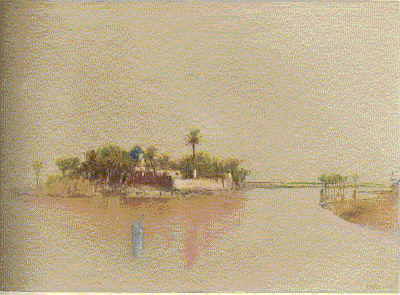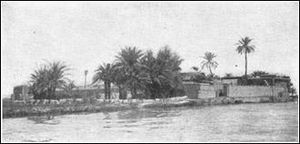
Ezra's Tomb
Encyclopedia

Iraq
Iraq ; officially the Republic of Iraq is a country in Western Asia spanning most of the northwestern end of the Zagros mountain range, the eastern part of the Syrian Desert and the northern part of the Arabian Desert....
on the western shore of the Tigris
Tigris
The Tigris River is the eastern member of the two great rivers that define Mesopotamia, the other being the Euphrates. The river flows south from the mountains of southeastern Turkey through Iraq.-Geography:...
that was popularly believed to be the burial place of the biblical figure Ezra
Ezra
Ezra , also called Ezra the Scribe and Ezra the Priest in the Book of Ezra. According to the Hebrew Bible he returned from the Babylonian exile and reintroduced the Torah in Jerusalem...
. Al-ʻUzair is the present name of the settlement that has grown up around the tomb.
History
The Jewish historian JosephusJosephus
Titus Flavius Josephus , also called Joseph ben Matityahu , was a 1st-century Romano-Jewish historian and hagiographer of priestly and royal ancestry who recorded Jewish history, with special emphasis on the 1st century AD and the First Jewish–Roman War, which resulted in the Destruction of...
wrote that Ezra died and was laid to rest in the city of Jerusalem. Hundreds of years later, however, a spurious tomb in his name was claimed to have been discovered in Iraq around the year 1050.
The tombs of ancient prophets were believed by medieval people to produce a heavenly light; it was reputed that on certain nights an "illumination" would go up from the tomb of Ezra. In his Concise Pamphlet Concerning Noble Pilgrimage Sites, Yasin al-Biqai (d. 1095) wrote that the “light descends” onto the tomb. Jewish merchants partaking in mercantile activities in India
India
India , officially the Republic of India , is a country in South Asia. It is the seventh-largest country by geographical area, the second-most populous country with over 1.2 billion people, and the most populous democracy in the world...
from the 11th-13th century often paid reverence to him by visiting his tomb on their way back to places like Egypt
Egypt
Egypt , officially the Arab Republic of Egypt, Arabic: , is a country mainly in North Africa, with the Sinai Peninsula forming a land bridge in Southwest Asia. Egypt is thus a transcontinental country, and a major power in Africa, the Mediterranean Basin, the Middle East and the Muslim world...
. The noted Jewish traveler Benjamin of Tudela
Benjamin of Tudela
Benjamin of Tudela was a medieval Jewish traveler who visited Europe, Asia, and Africa in the 12th century. His vivid descriptions of western Asia preceded those of Marco Polo by a hundred years...
(d. 1173) visited the tomb and recorded the types of observances that both Jews and Muslims of his time afforded it. A fellow Jewish traveler named Yehuda Alharizi
Yehuda Alharizi
Yehuda Alharizi, also Judah ben Solomon Harizi or al-Harizi was a rabbi, translator, poet and traveller active in Spain in the Middle Ages . He was supported by wealthy patrons, to whom he wrote poems and dedicated compositions.He was a rationalist, conveying the works of Maimonides and his...
(d. 1225) was told a story during his visit (c. 1215) about how a shepherd had learned of its place in a dream 160 years prior. Alharizi, after stating that he initially considered the accounts of lights rising from the tomb "fictitious", claimed that on his visit he saw a light in the sky "clear like the sun [...] illuminating the darkness, skipping to the right and left [...] visibly arising, moving from the west to the east on the face of heaven, as far as the grave of Ezra". He also commented the light that shown on the tomb was the “glory of God.” Rabbi Petachiah of Ratisbon
Petachiah of Ratisbon
Petachiah of Ratisbon, also known as Petachiah ben Yakov, Moses Petachiah, and Petachiah of Regensburg, was a Bohemian rabbi of the late twelfth and early thirteenth centuries CE. He is best known for his extensive travels throughout Eastern Europe, the Caucasus, and the Middle East.Petachiah was...
gave a similar account to Alharizi of the tomb's discovery.
Working in the 19th century, Sir Austen Henry Layer suggested the original tomb had probably been swept away by the ever-changing course of the Tigris since none of the key buildings mentioned by Tudela were present at the time of his expedition. If true, this would mean the current tomb in its place is not the same one that Tudela and later writers visited. It continues to be an active holy site today.
The shrine

Muslim
A Muslim, also spelled Moslem, is an adherent of Islam, a monotheistic, Abrahamic religion based on the Quran, which Muslims consider the verbatim word of God as revealed to prophet Muhammad. "Muslim" is the Arabic term for "submitter" .Muslims believe that God is one and incomparable...
and Jewish shrine, are possibly around 250 years old; there is an enclosing wall and a blue-tiled dome, and a separate synagogue
Synagogue
A synagogue is a Jewish house of prayer. This use of the Greek term synagogue originates in the Septuagint where it sometimes translates the Hebrew word for assembly, kahal...
, which though now disused has been kept in good repair in recent times.
Claudius James Rich
Claudius James Rich
Claudius James Rich , British business agent, traveller and antiquarian scholar,-Biography:Rich was born near Dijon....
noted the tomb in 1820; a local Arab told him that "a Jew, by name Koph Yakoob, erected the present building over it about thirty years ago". Rich stated the shrine had a battlemented wall and a green dome (later accounts describe it as blue), and contained a tiled room in which the tomb was situated.
The shrine and its associated settlement seem to have been used as a regular staging post on journeys upriver during the Mesopotamian Campaign
Mesopotamian Campaign
The Mesopotamian campaign was a campaign in the Middle Eastern theatre of World War I fought between the Allies represented by the British Empire, mostly troops from the Indian Empire, and the Central Powers, mostly of the Ottoman Empire.- Background :...
and British Mandate of Mesopotamia, so is mentioned in several travelogue
Travel literature
Travel literature is travel writing of literary value. Travel literature typically records the experiences of an author touring a place for the pleasure of travel. An individual work is sometimes called a travelogue or itinerary. Travel literature may be cross-cultural or transnational in focus, or...
s and British military memoirs of the time. T. E. Lawrence
T. E. Lawrence
Lieutenant Colonel Thomas Edward Lawrence, CB, DSO , known professionally as T. E. Lawrence, was a British Army officer renowned especially for his liaison role during the Arab Revolt against Ottoman Turkish rule of 1916–18...
, visiting in 1916, described the buildings as "a domed mosque and courtyard of yellow brick, with some simple but beautiful glazed brick of a dark green colour built into the walls in bands and splashes [...] the most elaborate building between Basra
Basra
Basra is the capital of Basra Governorate, in southern Iraq near Kuwait and Iran. It had an estimated population of two million as of 2009...
and Ctesiphon
Ctesiphon
Ctesiphon, the imperial capital of the Parthian Arsacids and of the Persian Sassanids, was one of the great cities of ancient Mesopotamia.The ruins of the city are located on the east bank of the Tigris, across the river from the Hellenistic city of Seleucia...
". Sir Alfred Rawlinson
Sir Alfred Rawlinson, 3rd Baronet
Sir Alfred Rawlinson, 3rd Baronet was a British pioneer motorist and aviator, soldier and intelligence officer, and sportsman. He was known as "Toby".-Life:...
, who saw the shrine in 1918, observed that a staff of midwives was maintained for the benefit of women who came to give birth there.
The vast majority of the Iraqi Jewish
History of the Jews in Iraq
The history of the Jews in Iraq is documented from the time of the Babylonian captivity c. 586 BCE. Iraqi Jews constitute one of the world's oldest and most historically significant Jewish communities....
population emigrated in 1951-52
Operation Ezra and Nehemiah
From 1950 to 1952, Operation Ezra and Nehemiah airlifted between 120,000 to 130,000 Iraqi Jews to Israel via Iran and Cyprus. The massive emigration of Iraqi Jews was among the most climactic events of Jewish exodus from Arab and Muslim countries. By 1968 only 2,000 Jews remained in Iraq...
. The shrine has continued in use, however; having long been visited by the Marsh Arabs
Marsh Arabs
The Marsh Arabs , also known as the Maʻdān , are inhabitants of the Tigris-Euphrates marshlands in the south and east of Iraq and along the Iranian border....
, it is now a place of pilgrimage for the Shi'a of southern Iraq. The Hebrew inscriptions of the wooden casket, the dedication plaque, and large Hebrew letters of God's name is still prominently maintained in the worshiping room.
Al-Uzair town
Al-Uzair is one of the two sub-districts of Qalat Saleh district, Maysan Governorate, Iraq. The town itself now has a population of some 14,000 people.See also
- Islamic view of Ezra
- TedefTedefTedef , also known as Tedef al-Yahud , is a town about 20 miles east of Aleppo, Syria. The town, which is the site of a shrine to the Hebrew prophet Ezra , was a popular summer resort for the Jews of Aleppo.-History:The village was inhabited during the 19th-century by Arabs belonging to the Aneyzeh...
, the location of another tomb attributed to Ezra in Syria.

